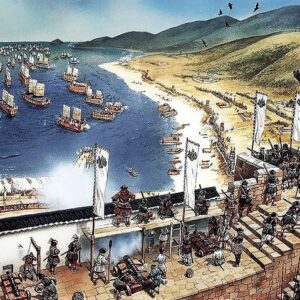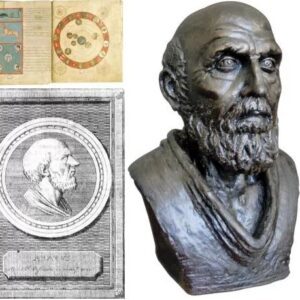
Richard III, the infamous King of England, met his tragic end at the Battle of Bosworth Field in 1485, marking the downfall of the once-mighty House of York and Plantagenet Dynasty. This defeat not only signaled the end of the Wars of the Roses, but also marked the transition from the Middle Ages to the modern era in England. However, the legacy of Richard III was far from over. Thanks in part to the bard William Shakespeare, he was forever remembered as a ruthless and cunning villain in history. After his death, he was laid to rest in Greyfriars, Leicester, but the dissolution of the friary in 1538 led to the disappearance of his tomb. Despite rumors that his remains were thrown into the River Soar, his body remained lost in its original resting place for over five centuries, until a groundbreaking search for the “Car Park King” would finally uncover the secrets of Richard III’s final resting place.
Battle of Bosworth Field

The fateful month of August in 1485 saw the culmination of the Wars of the Roses in the form of the Battle of Bosworth Field. The two warring factions of the House of York, led by King Richard III, and the House of Tudor, commanded by Henry Tudor, clashed in a fierce engagement that would determine the fate of the English crown. After over three decades of brutal conflict, the battle proved to be the decisive moment in English history. In a crushing blow to the Yorkists, Tudor’s forces emerged victorious, and Richard III fell in battle. Tudor was crowned Henry VII, becoming the first monarch of the House of Tudor and heralding the dawn of a new era in English history.
Rumors Circulate Over the Location of King Richard Iii’s Remains

Speculation and rumors have swirled for centuries about the final resting place of King Richard III. Despite being buried in Greyfriars, Leicester, following his death at the Battle of Bosworth Field in 1485, his tomb was lost during the dissolution and demolition of the friary in 1538. For over 500 years, the whereabouts of his remains remained a mystery, with some even suggesting that his body had been unceremoniously dumped into the nearby River Soar. However, in recent years, an incredible discovery would shed light on the truth and rewrite the history books.

For decades, the Richard III Society had been a driving force in the quest to locate the remains of the lost monarch. In 1975, they first suggested that his body may be lying under a car park in Leicester, a theory echoed by historian David Baldwin in 1986. However, it wasn’t until 2004-05 that the society’s Scottish branch member, Philippa Langley, delved deeper into the theory. With an unwavering conviction that Richard III was buried beneath the car park, she enlisted the help of historian John Ashdown-Hill to reach out to Channel 4’s Time Team. However, with the TV series only able to conduct three-day digs, the project was still out of their scope.
Undeterred, Langley continued her quest for answers and, after three long years, discovered a key piece of evidence that she deemed her “smoking gun.” It was a medieval map of Leicester, showing the location of Greyfriars Church. By comparing it to the modern-day layout, she was able to pinpoint the precise spot where the church once stood, and thus, the likely location of Richard III’s remains.
The “Looking for Richard: In Search of a King” project quickly garnered support and funding from the Richard III Society, Leicester City Council, and the University of Leicester, leading to an official excavation. With the stage set, the world held its breath in anticipation of what groundbreaking discoveries lay ahead.
Skeletal Remains Are Discovered Beneath the Car Park

In 2011, the search for Richard III’s remains took a significant step forward when initial surveys of the car park were conducted using ground-penetrating radar. The team faced a challenge, with modern infrastructure such as pipes and cables obstructing their path. Nonetheless, they pressed on, commencing excavation on August 22, 2012 – a date that held significant historical significance as it marked 527 years since Richard III’s death at Bosworth Field.
Remarkably, within just six hours of digging the first trench, human remains were discovered. Months of meticulous research and testing followed, with the skeleton ultimately confirmed to be that of Richard III. The body exhibited telltale signs of battle wounds and a curved spine, both consistent with historical accounts of the late king. Carbon dating placed the bones within the time frame of Richard III’s death, and age analysis suggested that they belonged to a man in his late 20s or early 30s, which aligned with the age of the king at his death.
To further confirm the identity of the remains, DNA testing was conducted by Turi King, with the aim of comparing the DNA with that of a confirmed relative. In 2005, historian John Ashdown-Hill had discovered a mitochondrial DNA sequence shared between Richard III and his sister, Anne of York, which would serve as a critical piece of evidence in the identification process. The DNA analysis provided a staggering 99.999% accuracy in confirming that the body was indeed that of the long-lost king.
In February 2013, the world was stunned by the official announcement of the discovery of Richard III’s remains by the University of Leicester. The find was nothing short of historic, marking the end of a centuries-long mystery and providing a fascinating glimpse into one of England’s most controversial and enigmatic monarchs.
Reinterment of King Richard III

Following the confirmation of the discovery of Richard III’s remains, plans were made for the reinterment of the long-lost king. After months of debate and discussion, it was decided that Leicester Cathedral would serve as the final resting place for Richard III.
The reinterment ceremony was held on March 26, 2015, and was attended by royalty, dignitaries, and members of the public. The coffin, adorned with Richard III’s coat of arms, was carried through the streets of Leicester in a solemn procession, with thousands of people lining the route to pay their respects to the lost king.
At the ceremony, a number of speeches were given, paying tribute to Richard III and reflecting on the significance of the discovery of his remains. The Archbishop of Canterbury, Justin Welby, presided over the service, which featured a number of readings, hymns, and musical performances.
Finally, after more than five centuries of mystery and speculation, Richard III was laid to rest with full honors in a specially constructed tomb within Leicester Cathedral. The reinterment was a momentous occasion, marking the end of a remarkable journey that had captured the imagination of people around the world and shining a light on one of the most fascinating and turbulent periods in English history.





